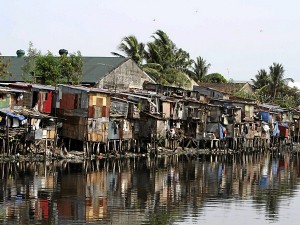Helping families move out of slums

IN ADDRESSING the housing needs in our country, SHDA believes that a roadmap must take into consideration urban dwellers living in slums. INQUIRER FILE PHOTO/JOAN BONDOC
Conclusion
The socialized medium-rise buildings (MRBs) the Subdivision and Housing Developers Association (SHDA) is proposing could play a key role in finally eliminating the country’s housing crisis.
The plan is interesting, considering that the country is still beset with a huge backlog of 3.9 million houses—a figure that could balloon to 6.5 million units by 2030—and private developers making the best of their current situation could only deliver just a little more than 200,000 units a year.
“We need everyone’s help and cooperation to create an enticing offer for our target market—the families living in slum communities. Thus, these houses that we are proposing must be located within an urban area, say Metro Manila, so that the basic infrastructure such as roads, piped water and electricity are already available and within reach. Also, the family breadwinners’ commuting distances between home and workplace must be short. Of course, these houses must not only be of decent construction but must be very affordable for them through monthly payments,” explained Paul Tanchi, national president of SHDA, which is the country’s largest organization of real estate developers.
SHDA’s socialized MRBs are five-story buildings that offer 125 units (25-square-meter floor area) each. Unit costs P550,000 each.
The SHDA proposal entails that the beneficiary family must be able to have access to a P550,000 loan that could be paid within 30 years at 4.5-percent interest (or P2,787 monthly) from the Home Mutual Development Fund or Pag-Ibig.
“But to make this plan work, we need the support of the national or the local government that will offer subsidy in the form of buildable land (no need for pile driving nor backfilling). These lands must not only be located within the city but their location must be near water and electricity supply, [have] access to proper drainage as well as paved road or near public transportation,” Tanchi said.
Moreover, he said, these government lands must be located outside danger zone and flood-prone areas.
P1B gov’t subsidy
“Assuming a P1-billion subsidy in the form of buildable land within Metro Manila is provided by the government, private developers may be able to produce a total of 3,448 socialized MRBs for the families living in informal settlements,” said Tanchi, who added that should the government decides to give a P7.5-billion subsidy (also in the form of buildable land within Metro Manila), private developers may be able to produce a total of 25,862 socialized MRB units for 129,310 beneficiaries.
To fast-track the delivery of such socialized MRBs, architect Jose de Guzman, SHDA senior adviser to the board of governors, said private developers will only require the quick approval of the concerned local government unit, the Housing and Urban Development Coordinating Council, the Housing and Land Use Regulatory Board (HLURB), the Board of Investments (BOI), the Department of Environment and Natural Resources, the Land Registration Authority, the Bureau of Internal Revenue and other concerned agencies.
Aside from the quick approval, De Guzman said the HLURB and the BOI must also recognize these socialized MRBs as compliant to the socialized housing requirement while the Social Housing Finance Corp. or the Home Development Mutual Fund (Pag-Ibig) must allow recipients of these socialized MRBs to avail a loan value of up to P550,000 at prevailing interest rate (currently at 4.5 percent), payable over a period of 30 years.
Ricky Celis, SHDA first vice president, explained that a P550,000 loan at 4.5 percent is already within reach of the target beneficiary families living in informal communities. He explained that a family that may be able to pay the P2,787 monthly amortization must only be earning at least a monthly gross income of P7,963.
Celis said: “A P7,963 monthly income that our target beneficiary families must be earning is way below the minimum monthly wage of P11,856. Thus, they should be able to afford a unit in our socialized MRBs.”
Better alternative
According to him, setting up the socialized MRBs within the city (Metro Manila) is a better alternative to the current strategy of developing socialized house-and-lot packages outside Metro Manila like those located in General Trias, Cavite, or in Marilao, Bulacan.
De Guzman said: “Based on our computation, a typical family living in a 18-square-meter house and lot worth P400,000, would have to spend P5,000 (if it’s located in General Trias, Cavite) or P3,300 (if it’s located in Marilao, Bulacan) a month on transportation alone if both breadwinners are working in Makati. Indeed, high transportation cost will negate the benefits of affordable housing units outside Metro Manila.”
Moreover, Celis said there were other unquantifiable social costs for residing far from the place of work that could negatively impact family life. “For example, the working father or mother won’t have enough energy left to spend quality time with the children after spending eight hours at work and several more hours of commuting,” he added.
In another computation, Celis presented that a family living in socialized MRB (25-sq-m unit costing P550,000) in Makati is projected to save P2,579 a month compared to a family living in an 18-sq-m house and lot (costing P400,000) in General Trias, Cavite. This, despite the fact that the family in Makati will had to pay a monthly amortization of P2,787 a month (4.5 percent for 30 years) versus the one living in Cavite that pays P2,027 a month (4.5 percent for 30 years).
De Guzman explained: “The key lies in the monthly transportation cost. While the family in Cavite has to set aside P5,000 a month for transportation expenses, the one in Makati only has to spend P1,500 a month.” He said the breadwinner residing in Makati will only have to deal with one to one and a half hours of daily commute while the one in Cavite has to endure four to five hours on the road.
